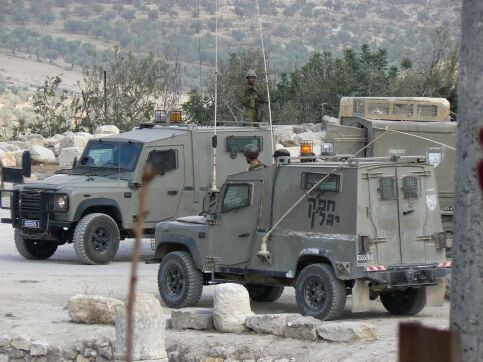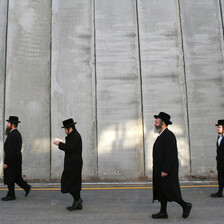The Electronic Intifada Sebastia 8 November 2010

The West Bank village of Sebastia.
I have in my possession two leaflets about Sebastia, an outrageously pretty little West Bank village which you’d never guess was once a major city, the capital of ancient kingdoms and home to an imposing Crusader cathedral which is now the village mosque.
The two leaflets describe pretty much the same set of archaeological sites, but they are very, very different. I picked up the first flyer at the new visitor information center in the Old City of Sebastia. The second I was given at the little Israel Nature and Parks Authority kiosk at the entrance to the major archaeological site on the hilltop above the village. The Parks Authority booth occupies a small stone building on the verge of the parking lot. A sign lists the entrance prices — 15 shekels (about four dollars) for adults — but the attendant says they don’t actually charge. He just fished out a leaflet for me, searching amongst boxes filled with flyers in Hebrew and several European languages.
The most obvious difference between the two leaflets is the sites they describe. The first covers the Roman, Byzantine and Crusader remains at the heart of the village, as well as the Ancient Greek, Roman and medieval remains on the hilltop, which is five-minute walk away. The second only mentions the latter. It also features a stern injunction: “Do not enter the village of Sebastye [Sebastia] without the express permission of the IDF [Israeli army] authorities. All visits to the National Park are subject to security regulations for visitors in Judea-Samaria,” the Israeli name for the occupied West Bank.
The archaeological “park” is actually a series of excavated buildings from various historical periods, surrounded by Palestinian olive groves which probably cover more remains going back to the Bronze Age. The Israeli authorities’ forbidding instructions to visitors of the park stem from the fact that the site is designated as Area C, so that it can be visited by Israeli citizens. The village, on the other hand, is Area A — Palestinian Authority-controlled — under the classifications which date back to the Oslo accords. Technically, Israeli citizens break the law by entering the village.
This, of course, has various implications. It means that Israeli visitors to the site get to see the versions of history that fit into their national myths — Greeks, Romans and a smattering of early Christianity. The existence of a vibrant society in Palestine throughout the Christian and Islamic periods down to the establishment of the State of Israel in 1948 — one which all the while incorporated Jewish as well as Christian, pagan and Islamic communities — is ignored. It also means that there are few opportunities for visitors coming with Israeli tours to interact with the modern-day Palestinian inhabitants of Sebastia; the presence of a living community is sidelined in favor of ancient remains. And it means that no income from most tourists to the site trickles into this little West Bank town.

Israeli soldiers in Sebastia.
An extreme example of this manifested itself just as I was leaving the archaeological “park,” having walked around the exposed ruins, watching Palestinian families resting under the trees as they picked this year’s olives. In the already-hot morning sun, four Israeli soldiers who seemed to be fixtures at the site were lurking on the edges of the parking lot, but the Palestinian manager of the cafe in which I was sitting had asked me insistently if there were any up by the church as well. One tour bus, loaded with British Syrian Orthodox pilgrims, had already pulled in with little fuss. They were visiting the “church” — the chapel where the severed head of St. John the Baptist is said to have been discovered — now a Byzantine ruin with Hebrew graffiti daubed on it.
Minutes later, three big Israeli army jeeps swept in. The cafe manager sucked his teeth and tutted, then positioned himself to watch the show. I got the impression he’d seen all of this before.
Perhaps a dozen soldiers leaped from the vehicles and spread out, scoped out their surroundings as if entering dangerous territory. Seconds later another tour bus appeared, this time laden with Israelis dressed in the style typical of religious settlers. As the group milled around for a good ten minutes, some of the soldiers settled themselves into watchful positions around the columns of the Roman forum. Others herded their settler flock into place and took them at a brisk pace off down the path leading to the first site on the circuit of the archaeological park. In contrast to the Syrian Orthodox group, most of whom were sitting on the terrace of the souvenir shop, buying cold drinks and chatting with the owner, the settler group had taken over the center of the car park, determinedly ignoring anyone else in it, bunching themselves into a defensive knot and ignoring the two cafes and two souvenir stores trying to scrape a living from visiting groups. They certainly weren’t going to buy any pottery or local olive oil soap. And they certainly wouldn’t be following their visit to the archaeological park with a trip into the Old City.
The busload of settlers might be a lost cause. But Sebastia’s residents and municipality want other tourists to venture beyond the main archaeological site and visit the village too. They hope that this will give visitors a richer and more complex view of the town’s history and society — and, of course, bring much-needed income. With this in mind, an Italian-funded project run in association with the municipality and the tourism-promoting Mosaic Center in Jericho has excavated and renovated some of the ancient buildings in the center of the Old City. It has uncovered significant new Crusader and Byzantine remains, including a spectacular mosaic and rehabilitated magnificent stone buildings to house a community center, a beautiful little guesthouse, and the visitor information center where I acquired the first of my leaflets.
But it may be that the project has an uphill struggle. On my return to Nablus, I mentioned the Israel Nature and Parks Authority kiosk to a friend whose job often entails picking his way through the politics of archaeology in Palestine. Naseer Arafat is a conservation architect from Nablus and he is all too well-acquainted with Israeli willingness to destroy ancient remains which don’t fit their historical agenda, and the claims which the Israeli authorities and settlers make on places which do. “What?” he demanded. “That kiosk wasn’t there before. That means they’ll close the site. You’ll see, maybe not now, but in a few years. They might not be taking money now, but they’ll put fences around it and charge to get in, and they won’t allow the farmers to reach their olive trees.”
All photos by Sarah Irving.
Sarah Irving is a freelance writer. She worked with the International Solidarity Movement in the occupied West Bank in 2001-02 and with Olive Co-op, promoting fair trade Palestinian products and solidarity visits, in 2004-06. She now writes full-time on a range of issues, including Palestine. Her first book, Gaza: Beneath the Bombs, co-authored with Sharyn Lock, was published in January 2010. She is currently working on a new edition of the Bradt Guide to Palestine and a biography of Leila Khaled.





